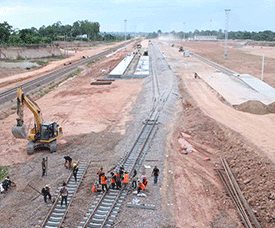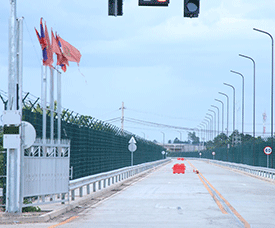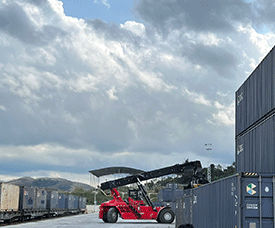The transformation of Laos from land-locked to land-linked
As the only landlocked country in South East Asia, Laos depends on neighbouring countries’ infrastructure to import and transport its goods. As a result, the success or failure of Laos depends on the efficiency of these countries’ infrastructure networks.
According to Nguyen and Notteboom (2016), the import of wine into the Lao capital Vientiane from Marseilles, France, proves the validity of a cost model for multimodal transport.
On the other hand, the import of wine tests the effectiveness of the model which is attributed to Beresford and Dubey in a real case scenario.
The test in international logistics applies elements such as the transfer cost, time taken, and distance covered. However, it also covers the intermodal transfer and the transport mode. The model uses real data that was collected from various routes between Marseilles and Vientiane.
A study by Philangam (2019) reveals that the establishment of a functional international logistics system directly contributes to the efficiency of an import system.
Informed by this realisation, the current study should establish whether the appropriateness of Laos’ international logistics system contributes to the efficiency of its import channels.
If not, the study should further investigate the challenges encountered, to determine how best the government can address them.
Laos’ international logistics system largely depends on the efficiency of the “sea-road” combination passing through the Danang port in Vietnam. According to the World Bank (2018), the Danang port is very competitive, contributing to the efficiency of Laos’ import sector. On the other hand, the “sea-rail-road” through port Klang in Malaysia, which also passes through Thailand, allows importers to use the least time to transit through.
Due to increasing international competition, manufacturers, exporters and importers are increasingly being forced to shoulder very high operational costs. The expansion of geographical markets has exacerbated the situation, forcing this group of traders to integrate production and logistics strategies to lower costs. They also intend to use the strategies to achieve higher service standards.
 |
 |
Therefore, the government needs to control the transport system to help reduce production costs and safeguard its people. In the last few decades, the most feasible way has been through the development of so-called dry ports, to ease the challenges associated with Laos being landlocked.
Many landlocked countries depend on neighbouring countries’ infrastructure to import and transport their goods. Others develop inland clearance depots to process imports on their own territory.
Arguably, the success or failure of these countries depends on the efficiency of their neighbours’ and their own infrastructure.
The current study has reviewed past articles on dry ports across the world. From the findings, different factors motivate the development of dry ports. Some of these factors include the development status of the country, congestion at gateway ports, and the need to open up trade in some regions.
There are some motivations on the development of dry ports as some researchers argue that dry ports are critical in enhancing port hinterland integration in instances where sea ports are regional. According to them, inland transportation nodes facilitate the movement of containers between the sea port and the hinterland.
Some of the notable facets of their arguments as stated in their research include inland clearance depots, inland container depots, inland ports, and dry ports.
After comparing the definitions of various scholars, they describe a dry port as a terminal that is located in the hinterland, whose function is to facilitate customs examination and the clearance of transit cargo. Due to these strategic functions, an inland clearance depot helps eliminate customs formalities at the nearest gateway or maritime port.
Nguyen and Nottebom (2016) also evaluated the various factors that contributed to the development of dry ports.
The paper by Nguyen and Nottebom (2016) is critical to this research since it presents some of the factors that could also have led to the emergence of dry ports in Laos. Some of the notable factors that Nguyen and Nottebom (2016) identify include the desire to create an economic zone or access the hinterland.
Another reason that motivates the development is the demand for additional facilities due to existing constraints at a sea port.
Expounding on the constraints faced by an existing sea port, Nguyen and Nottebom (2016) claim that the land where the port is situated could have little allowance for expansion, necessitating the development of a port
 |
in the hinterland where land is vast. Alternatively, the sea port could be experiencing environment-related problems which demand decongestion. In such a case, opening an inland clearance site is the most viable solution.
On the other hand, the sea port could be facing competition from another sea port. In response, the government can create a dry port to increase the efficiency of the sea port, making it more competitive. The third justification for inland ports according to Nguyen and Nottebom (2016) is the proximity of a vast land to a production line. The other theme that they addressed is the classification of dry ports.
As Nguyen and Nottebom (2016) point out, there as many classifications as there are inland ports. However, they highlight some of them like close dry ports which are also called satellite terminals, and close and mid-range distance terminals.
According to Pallis (2017), close dry port terminals are located near gateway ports with close connections to a railway or highway transport system.
Essentially, they are created to ease congestion in the sea port or act as its extensions. In contrast, the mid-range dry port is developed in the hinterland to consolidate or deconsolidate cargo from shippers. Usually, they are created where a land mass is available or with the intention of opening up the hinterland.
Nguyen and Nottebom (2016) also explored the development of dry ports in developing countries. According to them, different factors motivate the development of dry ports in developed and developing countries.
For instance, in developing countries, dry ports are intended to achieve complex objectives such as integration with several gateway ports.
On the other hand, the emergence of dry ports in developing countries is informed by the need to streamline the flow of raw materials and finished goods. Therefore, it is common to find dry ports near industrial zones in developing countries but not in developed countries.
IDE-JETRO (2017) on the other hand evaluated the logistics system between Laos and Thailand. According to the report, the Vientiane-Bangkok Port (640 kilometres) and the Savannakhet-Laem Chabang Port (716 kilometres) share a node at the T-Junction Highway. They also share a node at HW No. 304 near Nakhon Ratchasima.
Connectivity within the Thailand and Laos region made logistics easier due to the connectivity of the routes. IDE-JETRO (2017) also explored the trucks and trailers used in the region. According to them, the commonest vehicles were pickup trucks, articulated vehicles, six-wheel rigid vehicles, and ten-wheel rigid vehicles.
The report also estimated the logistics costs of operating within the region. From the findings, the logistical cost between Vientiane and Bangkok was US$1,407.5. Out of this figure, the transport cost was less than 51 percent. Therefore, cross border costs contributed to the remaining percentage, making it high.
In conclusion, many landlocked countries depend on neighbouring countries’ infrastructure to import and transport their goods. Others develop inland clearance depots to process imports on their own territory.
Arguably, the success or failure of these countries depends on the efficiency of these neighbours’ and their own infrastructure network.
The current study has reviewed past articles on dry ports across the world. From the findings, different factors motivate the development of dry ports. Some of these factors include the development status of the country, the congestion of gateway ports, and the need to open up trade in some regions.
--The above is the proposed topic for a PhD thesis by Souksakhone Phengsavath. He is Deputy Director of the Investment Appraisal Division at the Investment Promotion Department, Ministry of Planning and Investment.
By Souksakhone Phengsavath
(Latest Update July 19, 2022)
|